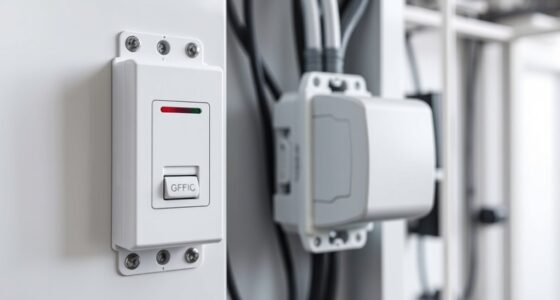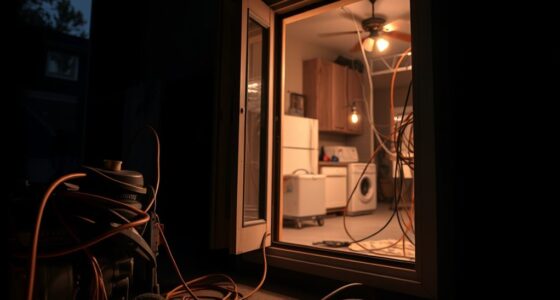The NEC requires GFCI outlets within six feet of water sources like sinks, tubs, and showers in your bathroom. These outlets quickly cut off power if they detect a ground fault, protecting you from shocks. Installing GFCIs in the right locations is key to staying safe and compliant with electrical codes. If you want to understand where and how to install them properly, there’s more to learn about making your bathroom safer.
Key Takeaways
- NEC requires GFCIs on bathroom outlets within 6 feet of sinks, tubs, and showers for safety.
- All bathroom receptacles, regardless of water proximity, must be GFCI protected per electrical codes.
- Proper GFCI installation includes secure wiring, correct placement, and circuit deactivation before work.
- Regular testing of GFCIs ensures they trip correctly and provide ongoing electrical safety.
- Outlets behind fixtures or far from water sources may violate code and reduce safety effectiveness.
What Are GFCIs and How Do They Protect You

GFCIs, or Ground Fault Circuit Interrupters, are safety devices designed to protect you from electrical shocks. They detect small differences in current between the hot and neutral wires, which can happen if electricity leaks to the ground—posing electrocution hazards. When a GFCI senses this imbalance, it quickly shuts off power, preventing a dangerous shock. This is essential for electrical safety, especially in areas like bathrooms where water increases the risk of electrocution. By interrupting the circuit almost instantly, GFCIs help keep you safe from unexpected shocks. Installing and testing these devices regularly ensures your safety is maintained, reducing the risk of serious injury caused by electrical faults. Proper installation and adherence to electrical safety standards are critical for ensuring these devices function correctly and provide maximum protection. They are a critical line of defense for electrical hazards, and protecting you from electrical hazards. Regular testing helps verify that the GFCI functions properly and continues to provide the intended safety benefits. Additionally, understanding AI vulnerabilities can help improve safety mechanisms in smart electrical systems. Recognizing soulmate angel numbers can also serve as reminders to stay attentive to your personal safety and emotional well-being during stressful or transitional periods.
Where GFCIs Are Required in the Bathroom

To guarantee safety in your bathroom, GFCIs are required in all areas where water and electrical outlets may come into contact. The GFCI history shows it’s been a vital safety feature since its introduction to prevent shocks. The NEC mandates GFCIs on outlets within 6 feet of sinks, bathtubs, and showers. This includes outlets on walls or floors near these fixtures. These regulations help reduce electrical hazards, especially in damp environments. Following bathroom safety tips, you should install GFCIs on all receptacles in the bathroom, not just those near water sources. This ensures that if a ground fault occurs, the GFCI trips immediately, protecting you from severe shocks. Understanding the role of ethical hacking in security can help identify vulnerabilities in electrical systems and prevent potential hazards. Always verify GFCI location and functionality during bathroom upgrades or renovations. Paying attention to electrical code compliance can further enhance safety and prevent violations. Incorporating mindfulness techniques during installation can also promote a safer and more focused approach to electrical safety procedures.
Understanding the Bathroom Outlet Rule and Its Purpose

Understanding the bathroom outlet rule is essential for guaranteeing your safety and compliance with electrical codes. This rule mandates that outlets in bathrooms be protected by Ground Fault Circuit Interrupters (GFCIs) to prevent electrical shocks. Its purpose is to enhance bathroom safety by reducing the risk of electrocution from water exposure. The rule covers outlets within a certain distance of sinks, tubs, and showers. Here’s a quick overview:
| Location | Requirement | Purpose |
|---|---|---|
| Near sinks | GFCI outlets required | Prevent shocks from water |
| Inside bathrooms | All outlets must be GFCI protected | Ensure safety |
| Within 6 feet of tub/shower | GFCI protection mandatory | Reduce electrocution risk |
| Outdoors or wet areas | GFCI outlets required | Maintain safety |
Following these guidelines is crucial for bathroom safety and staying compliant with electrical codes.
How to Identify and Install GFCI Outlets Properly

You need to know how to recognize GFCI outlets, which are designed to safeguard against electrical shocks. Proper installation guarantees they work correctly, so follow the right techniques when wiring or replacing them. Regular testing and maintenance keep your outlets functioning safely and reliably. Additionally, understanding lifestyle factors such as workspace organization and safety measures can help create a secure environment around electrical fixtures. Incorporating space optimization strategies can make it easier to access and maintain electrical outlets, reducing potential hazards. Being aware of best practices for maintenance can further ensure your GFCI outlets operate effectively over time. Staying informed about AI-powered safety tools can also enhance the monitoring of electrical systems in your home, adding an extra layer of protection. Understanding GFCI technology enhances your ability to troubleshoot and ensure safety.
Recognizing GFCI Outlets
GFCI outlets are designed to protect you from electrical shocks, and recognizing them is straightforward once you know what to look for. They often blend into bathroom decor, but certain features stand out. Here are four ways to identify a GFCI outlet:
- Test and Reset Buttons – Usually located in the center, these buttons are a clear sign of a GFCI.
- Label or Markings – Look for labels like “GFCI” or “Test” on the faceplate.
- Unique Design – GFCIs often have a different appearance compared to standard outlets, sometimes with a darker or more prominent face.
- Location – Typically installed in bathrooms, especially near sinks or plumbing upgrades to meet safety codes.
Knowing these signs helps you ensure bathroom safety and proper outlet choice.
Proper Installation Techniques
To guarantee safe and effective protection, proper installation of GFCI outlets is essential. First, ensure the outlet placement complies with NEC requirements, typically within 6 feet of a sink or tub. When installing, identify the ground fault path to ensure the GFCI can detect any imbalance between hot and neutral wires. Proper wiring connections are crucial; connect the hot (black) and neutral (white) wires securely to the correct terminals. The ground wire, if present, should be attached to the GFCI’s ground terminal. Always turn off the power before working and verify the circuit is dead. Correct placement and wiring will help the GFCI quickly detect ground faults, preventing electrical shock hazards in the bathroom. Additionally, understanding digital literacy programs can aid in troubleshooting and maintaining GFCI functionality effectively. Being familiar with circuit testing procedures can also ensure that the GFCI outlet is working correctly after installation. Regularly inspecting and performing maintenance checks on GFCI outlets can further enhance safety and reliability. Incorporating these practices can help maintain electrical safety standards and reduce the risk of electrical hazards.
Testing and Maintenance
Regular testing and maintenance are essential to guarantee your GFCI outlets function correctly and provide ongoing protection. To ensure outlet compatibility and circuit breaker testing accuracy, follow these steps:
- Press the test button on your GFCI to confirm it trips properly, then press reset to restore power.
- Use a GFCI tester to check if the outlet responds accurately to ground faults.
- Regularly inspect for any signs of damage or corrosion that could impair operation.
- Verify your circuit breaker is functioning correctly by performing circuit breaker testing, ensuring it trips during overloads or faults.
- Consult Ford Tuning resources to understand how electrical modifications or upgrades can impact your home’s safety systems and GFCI performance.
- Be aware that proper Hyundai Tuning techniques, especially in vehicle electrical systems, can serve as useful parallels for understanding circuit safety and testing.
- Remember that electrical safety is crucial, and routine testing helps prevent potential hazards before they become serious issues. Additionally, staying informed about ground fault mechanisms can improve your troubleshooting skills.
Performing these steps helps catch issues early, maintains outlet compatibility, and keeps your bathroom safe. Proper testing and maintenance are key to reliable GFCI protection.
Common Mistakes and Myths About Bathroom GFCIs

Many people forget to test their GFCIs regularly, which can leave their bathrooms vulnerable to hazards. Some believe water risks are exaggerated, leading to unsafe outlet placements or neglect. Mistakes like installing outlets in wrong locations can also compromise safety, so understanding common myths is key to proper protection. Recognizing the importance of prophetic dreams can help individuals better interpret guidance and avoid misconceptions about their significance. Additionally, awareness of home security systems can inform how homeowners protect their property from various risks, including electrical hazards. Incorporating passive voice detection tools into your editing process can further improve the clarity and safety of your writing. Embracing a mindful approach to creative practice can also enhance problem-solving and innovative thinking in troubleshooting electrical safety issues.
Overlooking GFCI Testing
Have you tested your bathroom GFCI lately? Many people overlook regular testing, which can lead to unseen electrical hazards. Without proper checks, water damage or small faults may go unnoticed, increasing the risk of shock or fire. Here are common mistakes to avoid:
- Skipping routine tests, leaving potential issues unaddressed
- Relying solely on visual inspection instead of actual testing
- Assuming GFCIs last forever without replacement or maintenance
- Ignoring warning signs like frequent trips or worn outlets
Misunderstanding Water Risks
Understanding water risks with bathroom GFCIs is essential because misconceptions can lead to dangerous situations. Many believe that GFCIs eliminate all electrical hazards, but their primary role is to prevent electric shock from ground faults. Some think water exposure alone causes GFCI trips, which isn’t true; GFCIs respond to imbalance, not water. To clarify, here’s a breakdown:
| Misconception | Reality | Impact on Water Safety |
|---|---|---|
| Water exposure automatically trips GFCI | GFCI trips only when a ground fault occurs | Reduces false alarms, enhances safety |
| GFCIs prevent all electrical hazards | They prevent shocks but don’t prevent water damage | Need additional water protection |
| GFCIs last forever | GFCIs require testing and occasional replacement | Ensures reliable protection |
Incorrect Outlet Placement
Incorrect placement of bathroom GFCIs is a common mistake that can compromise safety. Poor outlet placement in bathroom wiring can lead to hazards or code violations. Here are four mistakes to avoid:
- Installing outlets too far from the sink, reducing GFCI effectiveness.
- Placing outlets behind fixtures where they’re inaccessible.
- Omitting GFCIs on outlets near water sources, risking electric shock.
- Using regular outlets in areas requiring GFCIs, violating code.
Proper outlet placement guarantees you meet the NEC requirements and maximize safety. Remember, bathroom wiring needs careful planning to place GFCIs where they’re most effective, such as near sinks and tubs. Avoid these common mistakes to prevent electrical hazards and ensure your bathroom is both safe and code-compliant.
Staying Compliant With the NEC and Ensuring Bathroom Safety

To stay compliant with the NEC and guarantee bathroom safety, you need to follow specific wiring rules designed for wet environments. These rules prioritize electrical safety and ensure code compliance, reducing the risk of shocks or fires. Install GFCIs on all bathroom outlets, especially those within six feet of sinks or tubs, as required by code. Use proper grounding and breaker sizes to prevent overloads. Keep wiring protected from moisture, and avoid extension cords or daisy-chaining outlets. Regular inspections help confirm everything remains up to date and safe. By adhering to these standards, you protect yourself and your family while meeting legal requirements. Staying informed about the NEC ensures your bathroom wiring is both safe and compliant.
Frequently Asked Questions
Are Portable GFCI Adapters Compliant With Bathroom Outlet Regulations?
Yes, portable GFCI adapters are compliant with bathroom outlet regulations if they meet safety standards like UL listing. You should verify the adapter is specifically designed for bathroom use and has proper GFCI protection. Always check the compliance standards before using portable adapters in bathrooms to prevent electrical hazards. Using compliant portable GFCI adapters helps you stay within safety regulations and protect yourself from electrical shock.
How Often Should GFCI Outlets Be Tested for Safety?
You should test your GFCI outlets at least once a month to guarantee safety. Think of it as a quick outlet maintenance check that keeps your home safe from electrical hazards. Safety protocols recommend regular testing to catch any issues early. Simply press the test button, then reset. Regular testing helps prevent shocks and fire risks, giving you peace of mind knowing your GFCI is functioning properly when you need it most.
What Are the Signs of a Failing GFCI Outlet?
You’ll notice a failing GFCI outlet if it constantly trips without reason, or if it won’t reset after being tested. Also, if it feels warm or shows signs of damage, it’s a red flag. These issues increase the risk of a ground fault, which can lead to electrical shock. Always test GFCIs regularly and replace them if they fail to trip properly, ensuring your safety from ground fault hazards.
Can GFCIS Be Installed in Existing Bathrooms Without Rewiring?
Imagine flipping a switch and feeling confident your bathroom is safe—that’s GFCI installation in action. You can install GFCIs in existing bathrooms without rewiring, but it depends on your current setup. Sometimes, the wiring might need adjustments, so you should check for Rewiring considerations. Hiring a professional ensures the GFCI outlet gets installed properly, keeping your bathroom protected without unnecessary hassle or rewiring.
Are GFCI Outlets Necessary for Bathroom Fans and Lighting?
GFCI outlets aren’t typically required for bathroom fans and lighting under electrical codes, but they do enhance bathroom safety. While the NEC mainly mandates GFCIs for outlets near water sources, installing GFCIs on circuits powering fans and lighting can provide extra protection against electrical faults. Check your local codes, and consider adding GFCIs for improved safety, especially if your bathroom’s wiring isn’t recent or if you want extra peace of mind.
Conclusion
By now, you see that GFCIs are your bathroom’s safety superheroes, catching electrical faults before they turn into real trouble. Following the NEC bathroom outlet rule isn’t just about compliance—it’s about protecting yourself and loved ones. Think of GFCIs as your personal shield against electrical shocks. So, install, test, and stay vigilant; your bathroom’s safety depends on it. Keep your electrical system as safe as a lighthouse guiding ships through stormy seas.









